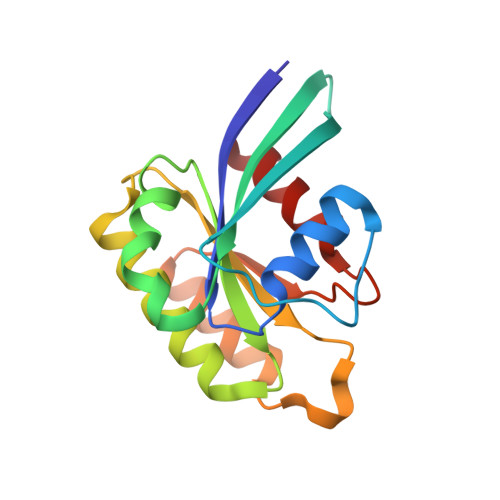Structural plasticity of an invariant hydrophobic triad in the switch regions of Rab GTPases is a determinant of effector recognition.
Merithew, E., Hatherly, S., Dumas, J.J., Lawe, D.C., Heller-Harrison, R., Lambright, D.G.(2001) J Biol Chem 276: 13982-13988
- PubMed: 11278565
- DOI: https://doi.org/10.1074/jbc.M009771200
- Primary Citation of Related Structures:
1HUQ - PubMed Abstract:
Rab GTPases function as regulatory components of an evolutionarily conserved machinery that mediates docking, priming, and fusion of vesicles with intracellular membranes. We have previously shown that the active conformation of Rab3A is stabilized by a substantial hydrophobic interface between the putative conformational switch regions (Dumas, J. J., Zhu, Z., Connolly, J. L., and Lambright, D. G. (1999) Structure 7, 413-423). A triad of invariant hydrophobic residues at this switch interface (Phe-59, Trp-76, and Tyr-91) represents a major interaction determinant between the switch regions of Rab3A and the Rab3A-specific effector Rabphilin3A (Ostermeier, C., and Brunger, A. T. (1999) Cell 96, 363-374). Here, we report the crystal structure of the active form of Rab5C, a prototypical endocytic Rab GTPase. As is true for Rab3A, the active conformation of Rab5C is stabilized by a hydrophobic interface between the switch regions. However, the conformation of the invariant hydrophobic triad (residues Phe-58, Trp-75, and Tyr-90 in Rab5C) is dramatically altered such that the resulting surface is noncomplementary to the switch interaction epitope of Rabphilin3A. This structural rearrangement reflects a set of nonconservative substitutions in the hydrophobic core between the central beta sheet and the alpha2 helix. These observations demonstrate that structural plasticity involving an invariant hydrophobic triad at the switch interface contributes to the mechanism by which effectors recognize distinct Rab subfamilies. Thus, the active conformation of the switch regions conveys information about the identity of a particular Rab GTPase as well as the state of the bound nucleotide.
Organizational Affiliation:
Program in Molecular Medicine and Department of Biochemistry and Molecular Pharmacology, University of Massachusetts Medical School, Worcester 01605, USA.
















